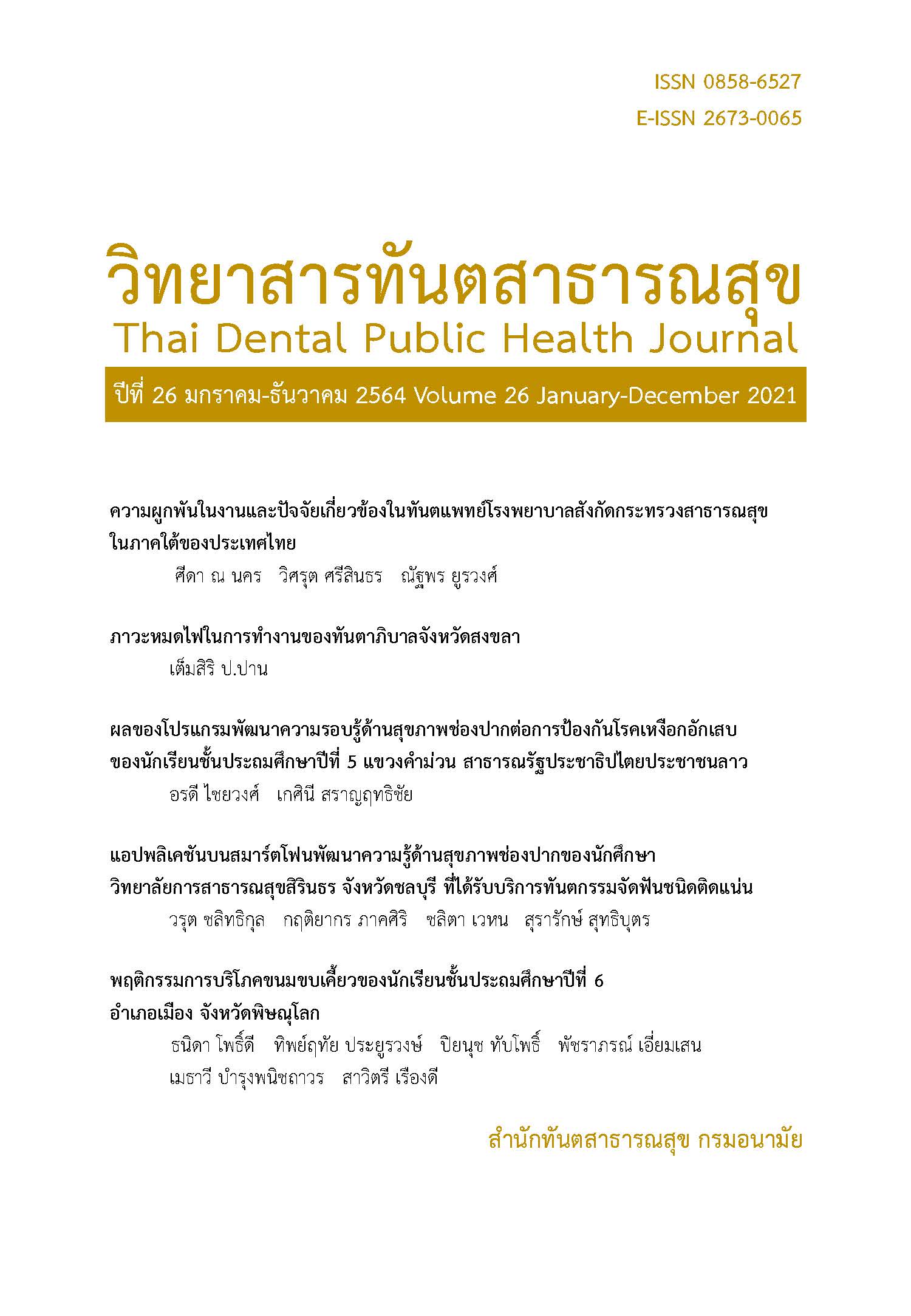A mobile application for improving oral health knowledge among Sirindhorn College of Public Health Chonburi students undergoing fixed orthodontic treatment
Main Article Content
Abstract
This pre-experimental research aimed to investigate the effect of using the mobile application “Just Fun” in improving oral health knowledge among 32 students of Sirindhorn College of Public Health Chonburi undergoing fixed orthodontic treatment. The self-administered questionnaire composed of three parts: 5 items of participants’ demographic and orthodontic treatment information, 20 items of oral health knowledge, and 10 items of satisfaction of using the application. The first two parts of the questionnaire were used to collect baseline data at the first week before the experiment. Then participants were asked to use the application to improve their oral health knowledge for two weeks. Their knowledge and satisfaction were measured at the end of the third week. The experiment was implemented from October to November 2020. The data were analyzed by descriptive statistics, paired t-test and Wilcoxon Matched Pairs Signed Ranks Test at the significance level 0.05. The result showed that the oral health knowledge score was increased significantly (p-value<0.05) and the average satisfaction score was at a high level.
Downloads
Article Details
References
Vorachart P, Huangyart P, Lelawattapanit M, Bonvoramatee A. The Influenced effect to attitude and desire for orthodontic treatment among year 2-undergraduate, 2552 academic year of Srinakarinwirot (Prasarnmit) University. [online]. 2014 [cited 2019 May 16] Available from: URL:https://www.gotoknow.org/posts/5 62887. (in Thai)
Atisook P, Chuacharoen R. Factors influencing demand for orthodontic treatment in a group of secondary school students in Bangkok. J DENT ASSOC THAI 2014; 64(4):243-55. (in Thai)
Richter AE, Arruda AO, Peters MC, Sohnd W. Incidence of caries lesions among patients treated with comprehensive orthodontics. Am J Orthod Dentofacial Orthop 2011; 139(5): 657-64.
Ahmed I, Saif ul H, Nazir R. Carious lesions in patients undergoing orthodontic treatment. J Pak Med Assoc 2011; 61(12): 1176-9.
Wishne M. Potential risks of orthodontic therapy: a critical review and conceptual framework. Aust Dent J 2017; 62(1):86-96.
Bureau of Dental Health. The 8th national oral health survey 2017 of Thailand. Nonthaburi: Department of Health; 2018. (in Thai)
Scheerman JFM, van Meijel B, van Empelen P, Verrips GHW, van Loveren C, Twisk JWR, et al. The effect of using a mobile application ("WhiteTeeth") on improving oral hygiene: A randomized controlled trial. Int J Dent Hyg 2020; 18(1): 73-3.
Alaiad A, Alsharo M, Alnsour Y. The Determinants of M-Health Adoption in Developing Countries: An Empirical Investigation. Appl Clin Inform 2019; 10(5): 820-40.
Electronic Transactions Development Agency. Thailand internet user behaviour 2020. Bangkok: Ministry of Digital Economy and Society; 2020. (in Thai)
Iyengar K, Upadhyaya GK, Vaishya R, Jain V. COVID-19 and applications of smartphone technology in the current pandemic. Diabetes Metab Syndr 2020; 14(5):733-37. doi: 10.1016 /j.dsx.2020.05.033.
Sharif MO, Siddiqui NR, Hodges SJ. Patient awareness of orthodontic mobile phone apps. J Orthod 2019; 46(1):51-5.
Pitiphat W. Determining the sample size. in Research methodology in dentistry. 3rd ed. Khon Kaen: Khon Kaen University press; 2017. p. 169-170. (in Thai)
Al-Silwadi FM, Gill DS, Petrie A, Cunningham SJ. Effect of social media in improving knowledge among patients having fixed appliance orthodontic treatment: A single-center randomized controlled trial. Am J Orthod Dentofacial Orthop 2015; 148(2): 231-7.
Zahid T, Alyafi R, Bantan N, Alzahrani R, Elfirt E. Comparison of effectiveness of mobile app versus conventional educational lectures on oral hygiene knowledge and behavior of high school students in Saudi Arabia. Patient Prefer Adherence 2020; 14:1901-09. doi: 10.2147/PP A.S270215.
Zotti F, Dalessandri D, Salgarello S, Piancino M, Bonetti S, Visconti L, Paganelli C. Usefulness of an app in improving oral hygiene compliance in adolescent orthodontic patients. Angle Orthod 2016; 86(1): 101-7. doi: 10.2319/010915-19.1.
Deleuse M, Meiffren C, Bruwier A, Maes N, Le Gall M, Charavet C. Smartphone application-assisted oral hygiene of orthodontic patients: a multicentre randomized controlled trial in adolescents. Eur J Orthod 2020: cjz105. doi: 10.1093/ejo/cjz105.
Alkadhi OH, Zahid MN, Almanea RS, Althaqeb HK, Alharbi TH, Ajwa NM. The effect of using mobile applications for improving oral hygiene in patients with orthodontic fixed appliances: a randomised controlled trial. J Orthod 2017; 44(3): 157-163. doi: 10.1080/14 653125.2017.1346746.
Tiffany B, Blasi P, Catz SL, McClure JB. Mobile apps for oral health promotion: Content Review and Heuristic Usability Analysis. JMIR Mhealth Uhealth 2018; 6(9): e11432 doi: 10.2 196/11432
Wong CA, Madanay F, Ozer EM, Harris SK, Moore M, Master SO, Moreno M, Weitzman ER. Digital health technology to enhance adolescent and young adult clinical preventive services: affordances and challenges. J Adolesc Health 2020; 67(2S): S24-S33. doi: 10.1016/j.jadohealth.2019.10.018.


